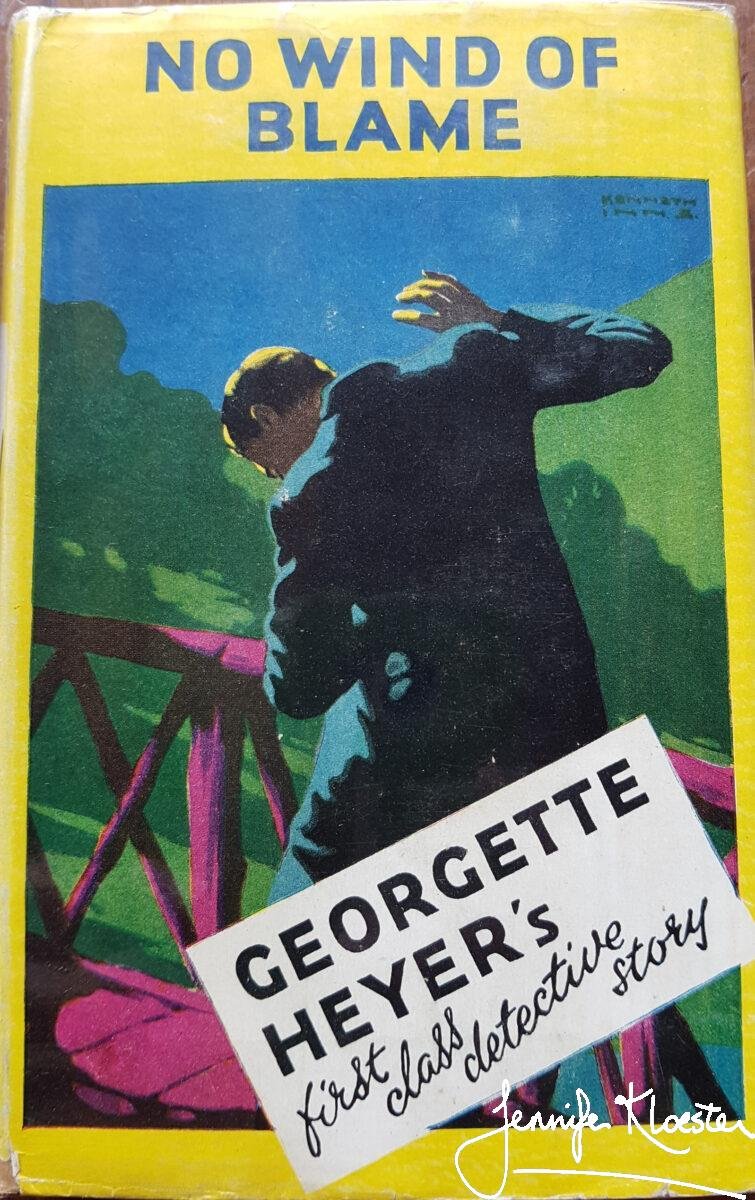To thine own peace. If he be now returned, As checking at his voyage, and that he means No more to undertake it, I will work him To an exploit, now ripe in my device, Under the which he shall not choose but fall; And for his death no wind of blame shall breathe, Hamlet, Act IV, scene 7, 70-75

A favourite with many readers of her detective novels, Georgette Heyer’s eighth outing in the mystery genre was No Wind of Blame. A delicious confection of witty dialogue and comic characters, she must have had great fun writing it. She rather enjoyed writing detective novels and in later years, her son, Richard, would explain that she thought of them ‘rather as one would regard tackling a crossword puzzle – an intellectual diversion before the harder tasks of life have to be faced.’ No Wind of Blame certainly shows Georgette in her element, creating a cast of characters who would make her readers laugh. Ermyntrude Carter is a middle-aged matron and former chorus-line dancer who, in the days of her youth and beauty, had married a very wealthy man and turned “respectable”. She lives in a grand house with a large staff and has one daughter from her first marriage. Vicky is one of the stars of the novel. An intelligent young woman and incurably honest, she is a natural actress and each day reveals herself in some new role complete with appropriate clothing. Vicky is by turns “The Sports Girl”, a Russian romantic, a “femme fatale“, “Sonia the Spy”, Arty girl, “Early Victorian”, “River Girl”, “One of the Younger Set”, and in an act of consummate strategy, “martyred murder suspect”. Georgette also took great delight in having a purported Russian prince arrive at “Palings” – Ermyntrude’s mansion – and Prince Varasashvili proves to be very good value, especially when he is called “Prince” and so is the family’s old spaniel! Halfway through the book, Heyer brings her clever detective, Hemingway (now promoted from Sergeant to inspector), onto the scene and there are some very funny scenes between the psychology-loving Inspector and the drama-loving Vicky, each of whom quickly (and accurately) takes the other’s measure.
Miss Georgette Heyer has strong claims to be considered the wittiest of detective story writers
Daily Mail

Inspector Hemingway
When Ermyntrude’s husband, the unpleasant, grifting, Wally Carter is murdered, the local police are baffled. While there are enough suspects, each with viable motives, the murder method proves impossible to solve and Inspector Hemingway of Scotland Yard is called to the scene. Wally has proved a poor choice of husband and, despite Ermyntrude’s generosity and tolerance for his many pecadilloes, was a resentful, whining fellow, forever on the take and who, to add to his sins, has made a local girl pregnant. It proves to be the final straw for Ermyntrude, and with the Prince urging divorce so that he might win her hand (along with her large fortune), the brother of the pregnant girl demanding recompense, their vulgar neighbour, Harold White, making free of Ermyntrude’s house and Vicky knowing far too much about various sensitive subjects, Georgette was in her element stage-managing the three-act comedy.
“One of the grandest comedy-situations I’ve handled yet”
No Wind of Blame was Heyer’s fourth book for Hodder and Stoughton, and by now she had taken the measure of the firm’s head, Percy Hodder-Williams. She knew him to be a man of principle, but she had also discovered that his devout Christian beliefs (the Hodder-Williams were Nonconformists) had more than once affected his business decisions and caused him to refuse publication of any book which he did not feel complied with the firm’s policy that their novels should have “nothing in them which would shock or harm any reader from ten to eighty”. It was this stance that prompted Georgette to tell her agent that No Wind of Blame was
“going on well, but I doubt whether it will please Uncle Percy. When I concocted a conventional motive for murder, & hung it on to a guiltless suspect, I did not foresee that this motive was going to get right out of hand, & develop rapidly into one of the grandest comedy-situations I’ve handled yet. But I won’t pretend that it’s quite nice, because it isn’t. I never write smut, nor have I a liking for prurient minds– preferring the broader, Elizabethan style! I can only tell you that some of the sallies have made Ronald shout with laughter – but they have also made him wonder “what-Uncle-Percy-will-say.” One good thing is that Uncle Percy can’t say much, because if he turns it down Frere would snap it up.’
Georgette Heyer to L.P. Moore, letter, 28 January 1939

The first “Cheap Edition” November 1939 
The Yellow Jacket edition 1940
A selling novel
However, Hodder & Stoughton knew a selling novel when they read one and in June 1939 they published No Wind of Blame. In the autumn of 1938, Georgette, like many Britons, had been keeping a close eye on the political situation in Europe and the day the British Prime Minister, Neville Chamberlain, signed the Munich Agreement and declared “Peace in Our Time”, she finally felt able to focus on the new novel. She confessed to being “quite played-out” by the events in Europe but assured her agent that she would “soon revive” and would then “bend her mind to the new thriller”. She warned him that it would be a little while longer before Ronald could “bend his mind to the thriller”, however, because his final Bar exams were pending and he would be unable to think of much else until they were done. It was Ronald’s job to work out the “how” of the murder mystery and Georgette’s to work out the who and the why. In the case of No Wind of Blame it seems that Ronald also had a hand in the “Why” of the murder, which proved to be so opaque that Georgette wrote to Moore to explain the thinking behind it:
For your private ear, the motive is highly technical, & the method of murder even more so. So obscure is it that although several vital clues are presented to the reader right at the start, I think it will be an exceptional reader who a) recognizes them as clues, & b) grasps their significance. You can tell H&S that much, if you like.
P.S. ‘I’m trying to work out this sort of reaction in the reader. Assuming “A” to be the murderer, the reader should feel
(1) A is obviously a villain.
(2) A is too obviously a villain.
(3) I hope A does the murder when there is a murder.
(4) I see A cannot have been the murderer.
(5) I am disgusted to find that, although suspicious, A was the last man to have desired Wally’s death.
(6) If A really did do it, why on earth?
(7) If A did it, how on earth?
Georgette Heyer to L.P. Moore, letter, 29 November 1938

Ronald’s murder method
Ronald devised a clever but complicated murder method – so clever that the War Office took an interest in it – but it certainly baffles any reader ignorant of the technical aspects of guns. Georgette had written most of No Wind of Blame and had reached the all-important denoument when everything is explained, only to find that she had no clear idea of just how her murderer had killed his man.
‘I DID know, broadly speaking, how the murder was committed, but I didn’t clutter up my mind with the incomprehensible details. Ronald swears that he came home one evening when I was at work on the final, explanatory chapter and that I said to him: “If you’re not busy, could you tell me just how this murder was committed?”‘
Reading the novel and reaching the final explanation, it’s fun to imagine Ronald explaining it all to Georgette and perhaps taking out one of his guns to demonstrate exactly how the deed was done. They were still living at Blackthorns when she wrote the novel and the house was home to many of the souvenirs and curios from their time in East Africa, among them Ronald’s guns which he had used for shooting big game. His experience with guns is easy to discern in No Wind of Blame and there is definitely something of Ronald in the character of the aptly named Robert Steel. There is also something of Georgette in the novel – or at least a reflection of her feelings about Richard. She was very much of her time in the way she responded to her son and her disinclination to overtly praise him or to express her deep love and affection for him is made clearer in the part of No Wind of Blame where she describes Sir William Dering’s attitude to his only son, Hugh:
‘Whenever anyone asked him questions about Hugh, he naturally disparaged him, and said that he was an idle young hound, and that he didn’t think he was all that clever (though, as a matter of fact, he took a first in Greats, for what that was worth), or particularly good at games (though actually he got his Rugger Blue, and had entered for the Amateur Golf Championship last year; not that that was anything to make a fuss about); but if Sir William had ever been obliged to enter a confessional, and to state his true opinion of his son, he would have said, with the utmost reluctance, that Hugh’s equal for character, brains, physique, athletic prowess, and general virtue did not exist.
Georgette Heyer, No Wind of Blame Heinemann, 1952, p.232.
“Equally entertaining and equally light-hearted”
No Wind of Blame would be Georgetrte’s last truly light-hearted modern novel for War was coming and soon she and Ronald would hear the guns across the Channel and know that not so many miles away, young men were being slaughtered on the battlefield. That hideous reality would soon make it hard for Heyer to write humorous modern dialogue and to depict bright young men bantering about murder when they were being killed. But Georgette Heyer’s novels would prove to be a much-needed escape from the horrors of war and No Wind of Blame was judged a delightfully comic novel and one which would stand the test of time.
‘Equally entertaining and equally light-hearted is Miss Georgette Heyer’s No Wind of Blame. The method used to murder a diverting but worthless individual is ingenious–too ingenious for belief; but what does that matter when we are laughing at the good-hearted vulgarity of Mrs Carter, the posing of her daughter, the floundering of the police-inspector, and the exquisite corrrectness of Prince Varasashvili (so awkward to have a prince as a guest when one’s own dog is called Prince)? Miss Heyer has produced a very funny book in which character-drawing and comic situation are well-matched. Murder, however, seems too heavy a stone to throw into the delightful ripples of life at Stilhurst
The Times, 4 July 1939, p.10







2 thoughts on “No Wind of Blame – a “Prince” of a novel”
Ms. Kloester – thank you for this marvelous post. I’ve loved all of Georgette Heyer’s books since I first read ‘A Civil Contract’ on what would be my last Pan Am flight into Africa (found it in a Lagos airport gift shop at 2am – it saved my sanity on the last, interminable legs of that flight) No Wind of Blame is one of the wittiest novels I’ve ever read and even now, 40 years later, I still chortle when trying to explain the whole ‘Prince’/Prince debacle (both at breakfast and with the Inspector. My lips are pursed as I type this, trying not to burst into laughter!!! I doubt I will be as successful at control as Hugh Dering ;-). Trying to hook my bf with ‘The Reluctant Widow’ because of the amazing Francis Cheviot… there are so many reasons for us to fall in love with Ms Heyer’s work. Your own books on her are marvelous as well, a real pleasure to read.
Hi Anita Thank you so much for the wonderful post and the great story about how you discovered Georgette Heyer. I think she would have loved to have known one of her novels was picked up in a bookshop in Lagos! I totally agree with you about No Wind of Blame – she loved the Prince/prince joke. Such a clever and witty novel! It’s always so easy to laugh when one just thinks of a Heyer novel, there are so many with laugh-out-loud scenes and characters in them! Thanks again for posting. Best wishes, Jen